History of our Club - 1950 to ...
28 April 1950 71 people attended a meeting. The club was formed and a committee elected.
14 May 1950 First trip to Wairere Falls, 56 people
June 1950 First Club Night
March 1951 First Bulletin
April 1951 Club becomes involved in SAR
September 1951 107 members
November 1951 Badge design selected from entries
January 1952 First SAR operation, the real thing
August 1952 Hut building committee formed, to build a hut somewhere in the Waikato
November 1953 First Wairongomai Hut working party
May 1954 Official Opening of Wairongomai Hut
June 1954 Waikato Hut building fund started
December 1954 First Waikato Hut working party
May 1955 First Junior member trip to Wairongomai
September 1955 Junior day trip to Maungatautari becomes day and a half
April 1956 Hut at Ruapheu named “Waikato Hut”
23rd June 1956 Official opening of Waikato Hut
September 1957 Pavlovich Bros become the Clubs transport operator
April 1959 Electricity installed in Waikato Hut
August 1963 Interest in building another hut – possibly at Waitawheta
February 1964 Health Dept declines permission to build at Waitaheta.
Inside toilet installed in Waikato Hut
July 1964 First Club marathon over Tuahu track and return
August 1964 Club entered a float in the Hamilton Centennial parade
October 1965 First crossing from Katikati to Waiorongomai
December 1965 Design a bush hut competition
March 1966 Plans to build a hut on top of Pirongia
November 1966 Hut design competition results in controversy and doubts about Pirongia. Other possibilities investigated
April 1967 Permission received to build in Waitengaue Valley
June 1967 First Waitengaue Hut working party
December 1967 First Tramper of the Year award
June 1968 Official Opening of Waitengaue Hut
December 1968 Tramper of the Year cup appears
March 1969 First Pirongia open climb run by Club. Postponed a week due to the weather but 209 people still took part
February 1971 Second Pirongia open climb – 300 people
May 1971 21st anniversary reunion of the club
June 1972 Plans to extend Waikato Hut
August 1972 Fundraising gets under way for the Hut Fund
January 1973 First working party for Waikato Hut extensions
March 1973 Third Pirongia open climb – 460 people
March 1975 Fourth Pirongia open climb – 500 people to the summit
August 1975 Official opening of Waikato Hut extension
March 1977 Fifth Pirongia open climb – 160 people – result of less advertising
1978 Telephone installed at Waikato Hut
March 1979 Sixth Pirongia open climb – 156 people
February 1980 Fundraising again. This time for fire alarm and emergency lighting system at Waikato Hut
May 1980 30th anniversary reunion
May 1980 Fire alarm and emergency lighting system installed in Waikato Hut
Sept 1980 Wairongomai Hut burnt down
Nov 1980 After discussions with NZ Forest Service, decision made not to replace Waiorongomai Hut
March 1981 Seventh Pirongia open climb – 100 people
March 1983 Eight Pirongia open climb – 201 people
April 1983 Tank room built around the back water tank at Waikato Hut
March 1983 First Club family trip to Whangamata
June 1983 A club member served on FMC executive
March 1985 Open bushcraft day instead of open climb
Nov 1985 Veranda added to Waitengaue Hut and walls lined with ply
March 1986 Solid fuel stove installed in lounge of Waikato Hut
July 1986 Volunteer members start driving buses for Club trips
Sept 1987 A chief guide appointed to help with trip planning
April 1989 21st anniversary of Waitengaue Hut celebrated.
A second informal Club Night started
May 1990 40th anniversary reunion
July 1990 Club obtains a Passenger Service Licence
April 1992 Rubbish hole filled in a Waitengaue – carry in, carry out policy adopted
1992-93 Aluminium joinery installed in Waikato Hut
May 1993 New roof on Waikato Hut
May 1993 Central fireplace removed from Waitengaue and the hut’s 25th anniversary celebrated
Winter 1994 Custodian at Waikato Hut for first time
Nov 1995 Club goes mountain biking – the 42 Traverse with weekend gear
June 1996 Another club member serves on FMC executive
May 2000 50th Anniversary reunion
April 2002 Waitengaue Hut burnt down
2010 50th anniversary reunion
2010 Personal Locator Beacons and fly to be taken on all trips
2010 Clubs financial accounts went online
2012 Bunk room upgrade at Waikato Hut completed
July 2012 Lounge at Waikato Hut names “King Family Lounge”
March 2013 Russell King has made two dining tables out of recycled native timber for Waikato Hut
Dec 2013 SGM to discuss a new structure for the club – General Committee manages the club with two separate sub committees
– Tramping and Ski. Two new membership categories – Senior Ski and Junior Ski were created.
Jan 2014 New club structure begins
Waitengaue Hut 1968 - 2002
"In 1980 we lost Waiorongomai Hut to fire and many Club members at the time wondered how long it would be before Waitengaue Hut suffered the same fate. I guess an optimist would say that we got an extra 22 years pleasure from it. Small comfort for something that should not have happened. On Easter Saturday 2002 at approximately 10.00 am, Waitengaue Hut was burnt down to the ground and all that remained was a pile of iron.
The present site in the Waitengaue Valley was discovered and in April 1967, permission was received to build. In June 1967 the first Waitengaue Hut working party was held. All materials were carried in to the site by members and the track from the road end to the site was divided up into thirteen sections. People were assigned to each section and were responsible for carrying materials over that section. A race soon developed as it was the aim of the people in each section to have a stockpile at the end of their section and this meant that much material was shifted quickly. During the construction, fundraising was also going on and funds managed to keep abreast of monies going out for materials.
|
Section 4 materials waiting for Section 5 |
The roof goes on |
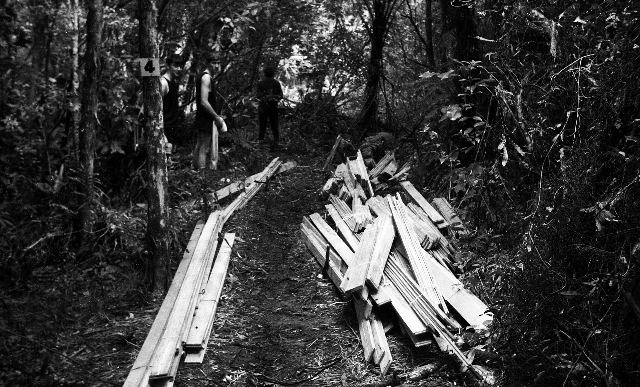 |
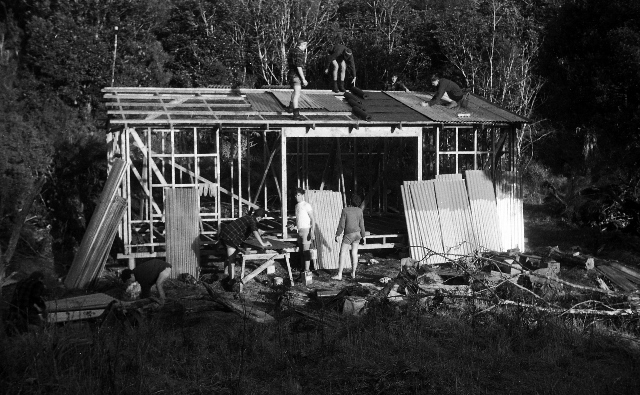 |
|
The workers |
Nearly there, ready for opening |
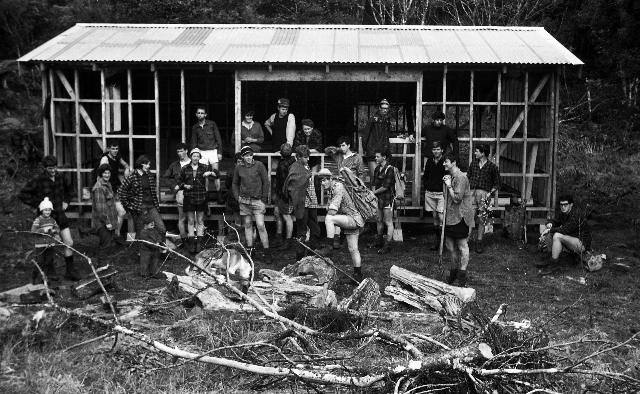 |
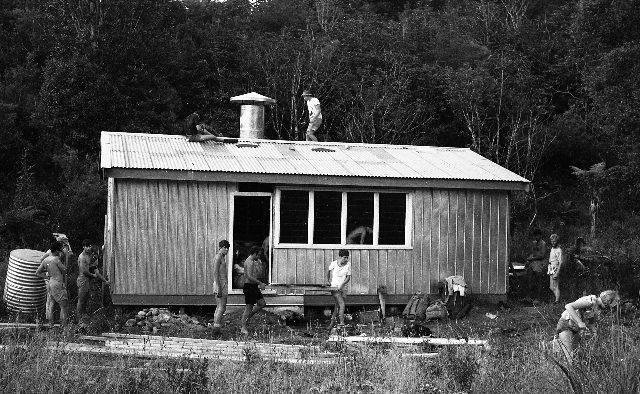 |
|
Chimney in position |
Waitengaue had a raised fireplace in the centre of the room |
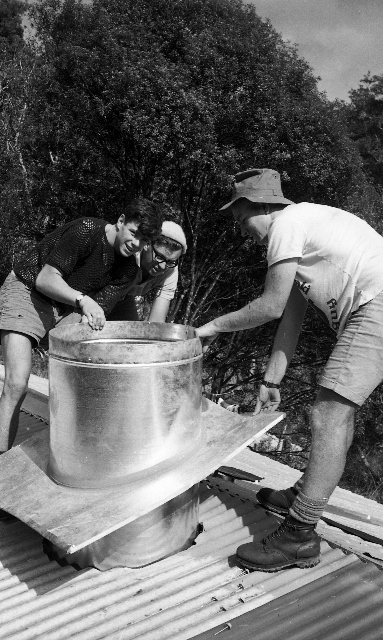 |
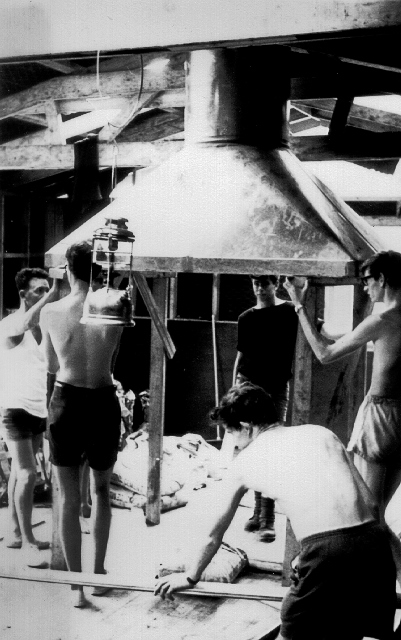 |
One year after the first working party, the hut was opened and it was opened in style. Bow ties, a push bike and lots of sparkling brown. One member, who was later to become president, took three attempts to get out of his tent to go to the loo the next morning.
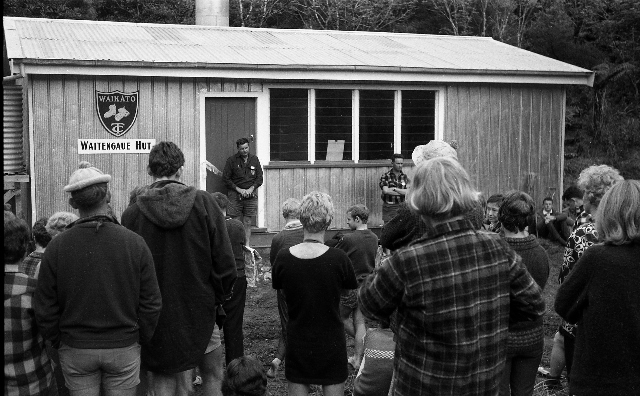 |
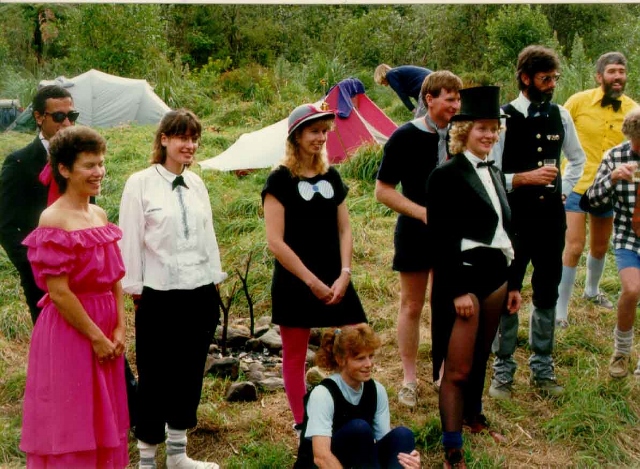 |
The hut was used a lot by our Club and outside organisations and one feature of the hut was the raised fireplace that sat in the middle of the room. Architecturally it was a huge success, but from an engineering point of view, it was a heavy structure which eventually made the floor around it sink. An inspection underneath showed that it was sitting on one pile, so a working party was arranged and with hydraulic jacks and ground treated timber, the problem was rectified.
A veranda was added to Waitengaue Hut and the walls were lined with ply in 1985. This made a big difference to the hut, particularly during wet weather and for just sitting outside, contemplating the world. In 1992, the rubbish hole was filled in (a carry in-carry out policy was adopted) and in 1993, the central fireplace was removed (people were chopping down trees close to the hut and even chopping up the table, doors, seats or what ever, just to get firewood).
Unfortunately, Waitengaue Hut was always subject to vandalism, minor, more annoying vandalism in the earlier days, with more serious and costly vandalism as time went on. It was obvious that the hut was too close and too easy to get to for the undesirable element and they have had the last say.
Waitengaue Hut was not flash, but it was a well designed 34 year old bush hut in reasonable condition that provided warmth and shelter at a beautiful tramping site. I joined the Club in 1968 and spent a lot of time helping build the hut. I enjoyed using the hut and the company of the people staying there. We always had a great time, although the water at the hut was not the best - it often gave one a headache on Sunday morning! Our kids enjoyed the hut. I think they were three when they first went there and always enjoyed going as did the kids of other Club members. I am sad to think that the hut is no more and its loss will deprive many people of a lot of pleasure for both now and in the future.
Four committee members met with DoC after the fire and we all agreed that rebuilding the hut is not an option. DoC are having the same problems with their huts which are near to the road ends and the current thinking is that the present site could become a camping site with a shelter. No decision has been made about this as yet and Club members will be advised and possibly asked for input. What we need to do when the dust settles is to set a date for a weekend for members to visit the site and have a big party. We need to remember what Waitengaue Hut has meant to us, the enjoyment it has given us and the memories it has left with us and we need to farewell a memorial to the early members of the Club which has now been lost."
Waiorongomai Hut 1954 - 1980
Before the days of well-marked and cut tracks the WTC members took an interest in exploring the Waiorongomai Valley in the Kaimai Ranges where they uncovered the relics of past gold-mining activities buried beneath gorse. When they found a brick chimney standing alone deep in the forest in 1953 they decided that it was a great spot to build a hut.
Permission was obtained to take over this historic relic and on May 1,1954, after 6 months of hard toil by Club members, the Waiorongomai Hut was officially opened. The Waiorongomai Valley was looked upon at the time as the Club's stamping ground and the Hut became a home for early members who spent many days and weekends exploring the area.
|
.jpg) |
.jpg) |
.jpg) |
.jpg) |
.jpg) |
|
In the 3Oth Reunion Bulletin it was noted that vandals were damaging the hut and that Club members could easily lose it. How unfortunate it was that this prediction came true only 5 months later.
On September 7, 1980, the Waiorongomai Hut was burned to the ground by vandals - only the original brick chimney survived the fire, the base of which can still be seen today. Forest Park regulations at the time dictated that the Club could not rebuild on the site, thus came the end of an era. |
The Wilson Family, December 1979
|
Trampers of the Year
| 1967 | Diane Purvis | 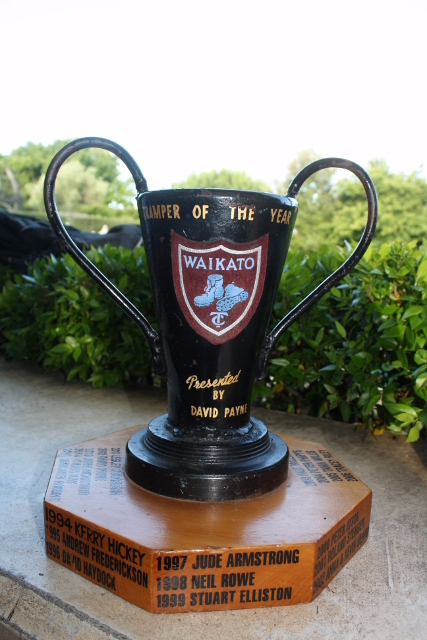 |
| 1968 | Jean Wilson (nee Eccersall) | |
| 1969 | Noel Burnie | |
| 1970 | Cedric Hagyard | |
| 1971 | Irene Dawson (nee Watt) | |
| 1972 | Brian McInally | |
| 1973 | Ian Smith | |
| 1974 | Nigel Lancaster | |
| 1975 | Debbie Discombe (nee Cowper) | |
| 1976 | Ross Clarke | |
| 1977 | Kathryn Goodchild | |
| 1978 | Adrian Widgery | |
| 1979 | Trish King (nee Stubbs) | |
| 1980 | Annemarie Lamb (nee Gibbs) | |
| 1981 | Graeme King | |
| 1982 | Kelvin Baxter | |
| 1983 | Jill Boswell (nee Davis) | |
| 1984 | Eric Zwaan | |
| 1985 | Russell Lamb | |
| 1986 | John Wilson | |
| 1987 | Rob Argent | |
| 1988 | David Boyd | |
| 1989 | Lynne Bjarnesen (Wood) | |
| 1990 | Beverley McGowan | |
| 1991 | Ian Fraser | |
| 1992 | Dianne June (nee Mannering) | |
| 1993 | Tim Foster | |
| 1994 | Kerry Hickey | |
| 1995 | Andrew Fredrickson | |
| 1996 | David Haydock | |
| 1997 | Jude Armstrong | |
| 1998 | Neil rowe | |
| 1999 | Stuart Elliston | |
| 2000 | Peter Ayson | |
| 2001 | Roland Stenger | |
| 2002 | Anna and Kevin Hearn | |
| 2003 | Paul McLennan | |
| 2004 | Peter Phipps | |
| 2005 | Tania Willis | |
| 2006 | Tracey Riley | |
| 2007 | Alan Wilson | |
| 2008 | Stuart Kneebone | |
| 2009 | John Davies | |
| 2010 | Dianne Ngapo | |
| 2011 | Lesley Kuggeleijn | |
| 2012 | David Payne | |
| 2013 | John McArthur | |
| 2014 | Chris Kay | |
| 2015 | Margaret Robbins | |
| 2016 | Stephen Prendergast | |
| 2017 | Allan Wickens | |
| 2018 | Jacqui Dick | |
| 2019 | Selwyn June | |
| 2020 | Judith Bogle | |
| 2021 | Les Warren | |
| 2022 | Mike Peck | |
| 2023 | Jim Scott |

.jpg)